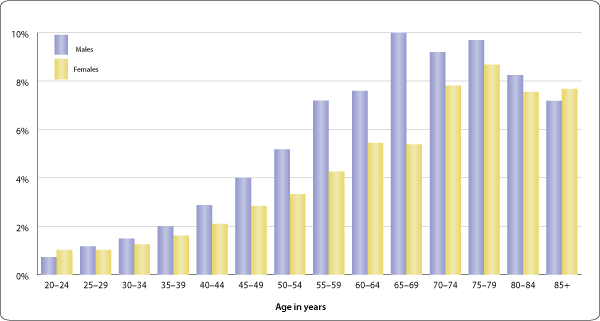Prevalence of Chronic Tinnitus

[text version]
This figure shows age and sex-specific trends in chronic tinnitus, i.e., ringing, roaring, or buzzing in the ears or head that has lasted for 3 months or longer in the past year. This information was collected in household interviews conducted as part of the 1994–1995 Disability Supplement to the U.S. National Health Interview Survey; the data are self-reported and exclude proxy responses. The overall trend with age shows a marked increase for both sexes, beginning about age 40, peaking between 65 to 79 years, and then declining after 80 years of age. Males show significantly higher rates of tinnitus (p<0.0001) compared to females. The male prevalence is consistently higher from age 40 through 79 years, with the largest differences between males and females occurring from 50 through 69 years of age. One explanation for these differences is that males are more likely to be exposed to loud environmental noise, whether through work or leisure activities. Strong associations between occupational noise exposure and tinnitus are well documented in the literature (Hoffman and Reed, 2004).
Source: 1994–1995 National Health Interview Study Disability Supplement. Chart created by the NIDCD Epidemiology and Biostatistics Program.
Reference
- Hoffman HJ, Reed GW. Epidemiology of tinnitus. In: Snow JB Jr, ed: Tinnitus: Theory and Management. Hamilton, Ontario: B.C. Decker, Inc. 2004; 16–41.